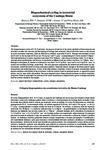Please use this identifier to cite or link to this item:
http://www.alice.cnptia.embrapa.br/alice/handle/doc/943753Full metadata record
| DC Field | Value | Language |
|---|---|---|
| dc.contributor.author | MENEZES, R. S. C. | pt_BR |
| dc.contributor.author | SAMPAIO, E. V. S. B. | pt_BR |
| dc.contributor.author | GIONGO, V. | pt_BR |
| dc.contributor.author | PÉREZ-MARIN, A. M. | pt_BR |
| dc.date.accessioned | 2013-01-02T11:11:11Z | pt_BR |
| dc.date.available | 2013-01-02T11:11:11Z | pt_BR |
| dc.date.created | 2013-01-02 | pt_BR |
| dc.date.issued | 2012 | pt_BR |
| dc.identifier.citation | Brazilian Journal of Biology, São Carlos, v. 72, n. 3, p. 643-653, 2012. | pt_BR |
| dc.identifier.uri | http://www.alice.cnptia.embrapa.br/alice/handle/doc/943753 | pt_BR |
| dc.description | The biogeochemical cycles of C, N, P and water, the impacts of land use in the stocks and flows of these elements and how they can affect the structure and functioning of Caatinga were reviewed. About half of this biome is still covered by native secondary vegetation. Soils are deficient in nutrients, especially N and P. Average concentrations of total soil P and C in the top layer (0-20 cm) are 196 mg kg?1 and 9.3 g kg?1, corresponding to C stocks around 23 Mg ha?1. Aboveground biomass of native vegetation varies from 30 to 50 Mg ha?1, and average root biomass from 3 to 12 Mg ha?1. Average annual productivities and biomass accumulation in different land use systems vary from 1 to 7 Mg ha?1 year?1. Biological atmospheric N2 fixation is estimated to vary from 3 to 11 kg N ha?1 year?1and 21 to 26 kg N ha?1 year?1 in mature and secondary Caatinga, respectively. The main processes responsible for nutrient and water losses are fire, soil erosion, runoff and harvest of crops and animal products. Projected climate changes in the future point to higher temperatures and rainfall decreases. In face of the high intrinsic variability, actions to increase sustainability should improve resilience and stability of the ecosystems. Land use systems based on perennial species, as opposed to annual species, may be more stable and resilient, thus more adequate to face future potential increases in climate variability. Long-term studies to investigate the potential of the native biodiversity or adapted exotic species to design sustainable land use systems should be encouraged. | pt_BR |
| dc.language.iso | por | pt_BR |
| dc.rights | openAccess | pt_BR |
| dc.subject | Floresta seca tropical | pt_BR |
| dc.subject | Fluxo de nutrientes | pt_BR |
| dc.subject | Bioma Caatinga | pt_BR |
| dc.subject | Natural resource | pt_BR |
| dc.title | Biogeochemical cycling in terrestrial ecosystems of the Caatinga Biome. | pt_BR |
| dc.type | Artigo de periódico | pt_BR |
| dc.date.updated | 2013-02-07T11:11:11Z | pt_BR |
| dc.subject.thesagro | Caatinga | pt_BR |
| dc.subject.thesagro | Biodiversidade | pt_BR |
| dc.subject.thesagro | Recurso natural | pt_BR |
| dc.subject.thesagro | Carbono | pt_BR |
| dc.subject.thesagro | Fósforo | pt_BR |
| dc.subject.thesagro | Nitrogênio | pt_BR |
| dc.description.notes | Suplemento 3. | pt_BR |
| riaa.ainfo.id | 943753 | pt_BR |
| riaa.ainfo.lastupdate | 2013-02-07 | pt_BR |
| dc.contributor.institution | UFPE; VANDERLISE GIONGO, CPATSA; Instituto Nacional do Semiárido. | pt_BR |
| Appears in Collections: | Artigo em periódico indexado (CPATSA)  | |
Files in This Item:
| File | Description | Size | Format | |
|---|---|---|---|---|
| Vanderlise2012.pdf | 799.41 kB | Adobe PDF |  View/Open |









